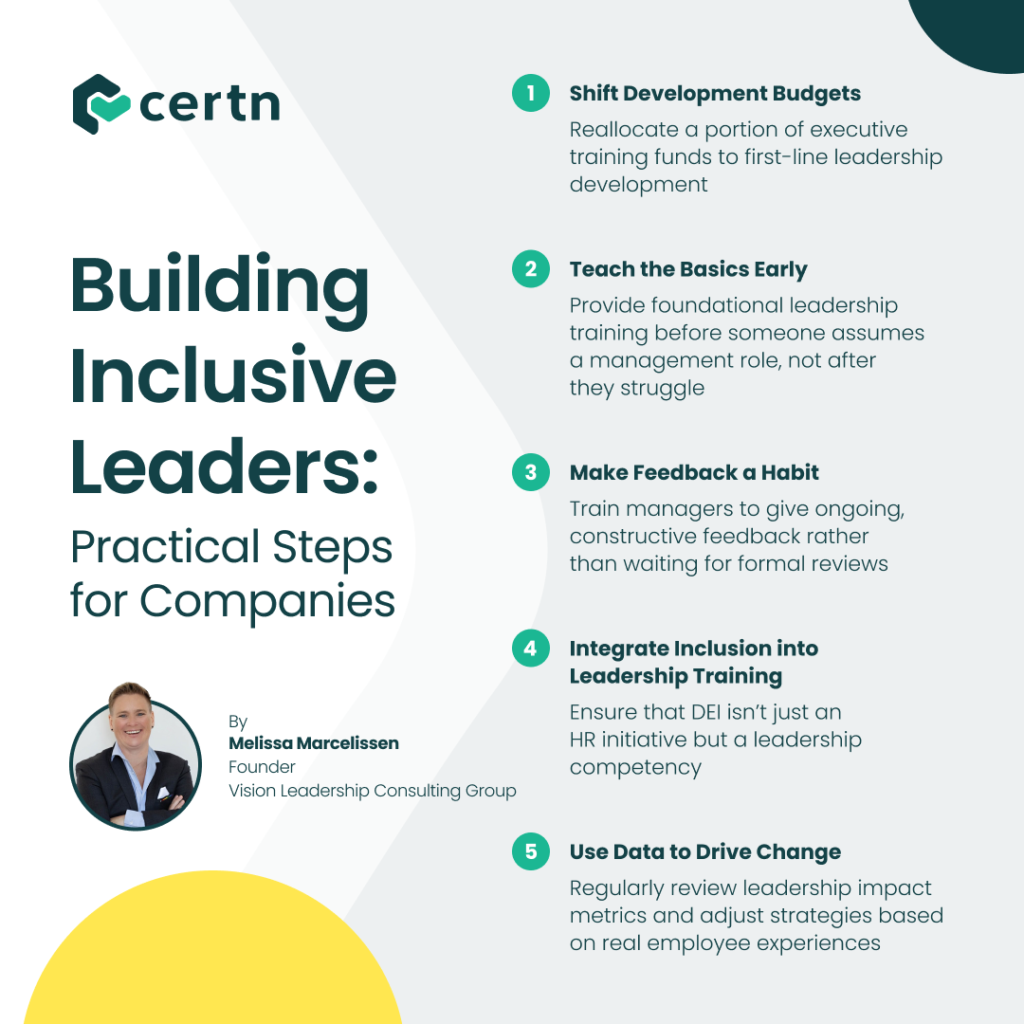What the FTE? is a podcast by Certn where we explore the tough questions surrounding the future of work, risk management, and employee experience. Whether you’re an HR leader, a TA newbie, or simply curious about the changing nature of work, this podcast provides you with practical insights to help you secure your seat at the table.
This week Certn’s CEO, Andrew McLeod, interviews Melissa Marcelissen. With over 20 years of experience as a strategic leader in organizational transformation, Melissa specializes in guiding companies through complex change initiatives while fostering inclusive, high-performing cultures where every employee feels a genuine sense of belonging. As the founder of Vision Leadership Consulting Group, Melissa offers leadership development and coaching for inclusive cultures and Equity, Diversity, Inclusion & Belonging (EDIB) strategy development.
—
Executives set the vision, but first-level leaders, the managers and team leads who interact with employees daily, are the ones who bring it to life. Yet, many organizations pour resources into executive leadership development while leaving first-time managers to figure things out on their own.
This is a mistake with serious consequences.
Melissa Marcelissen, a strategic leader with over 20 years of experience and an expert in organizational transformation points out that first-line leaders often miss out on development opportunities.
A survey of 4,5000 workers and managers by the Chartered Management Institute (CMI) found that four in five (82%) of those who entered management positions had not had any proper training, known as “accidental managers.” This lack of training can lead to ineffective leadership, employee dissatisfaction, and difficulty managing teams.
Frontline leaders have a disproportionate impact on team culture, well-being, and retention, so upskilling managers, teaching them the practical skills to keep their teams motivated and engaged can really make a difference. In fact, their influence on an employee’s day-to-day experience is often greater than that of their spouse or therapist.
So why do companies continue to underinvest in their development?
The Overlooked Power of First-Level Leaders
First-level leaders shape whether employees feel heard, valued, and supported. They decide who gets stretch assignments, who receives feedback, and who gets recognized. Their ability to foster psychological safety directly affects innovation, engagement, and productivity.
Melissa nails it when she says, “You may have heard the saying, ‘Your culture is never better than the worst behaviour you’re willing to tolerate.’” That means if your frontline managers aren’t equipped to uphold the culture you want, it won’t matter what the execs say, it’s not going to happen. If managers lack inclusive leadership skills, avoid tough conversations, or fail to communicate clearly, no amount of executive messaging about “culture” will fix it. Employees will check out, and turnover will rise.
Despite this, companies often assume that great individual contributors will naturally transition into effective leaders. They won’t, at least not without training. Inclusive leadership training goes beyond basic leadership skills by emphasizing the development of empathy and a deep understanding of diverse perspectives, but if basic management training isn’t happening, it’s unlikely your managers, new and old, are equipped to address issues such as unconscious bias, microaggressions, and creating inclusive workplaces.
Leadership is a skill that requires practice and development.

The Training Gap: Why First-Level Managers Are Set Up to Fail
Melissa sums it up perfectly: “There’s this assumption that frontline managers will pick it up as they go. Why? It just doesn’t even make sense.”
A 2025 Gartner report found that 75% of HR leaders say managers are overwhelmed by expanding responsibilities. Without proper support, they resort to survival mode, prioritizing short-term tasks over the long-term development of their teams. This lack of training leads to inconsistent management practices, poor feedback culture, and avoidable performance issues.
The Hard Conversations That Make (or Break) Culture
One of the most critical skills for first-time managers is the ability to deliver timely, constructive feedback. Yet, many avoid difficult conversations out of fear of conflict or discomfort. This avoidance leads to unspoken frustrations, declining performance, and ultimately, employees feeling blindsided when things escalate.
Melissa points out: “Not giving feedback feels easy at the moment, but it always gets worse. If we just keep ignoring it, it gets so bad that there’s no path back.”
Performance improvement plans (PIPs) are a prime example of where companies get it wrong. Too often, PIPs are used as a last resort instead of a continuous tool for development. If a manager is regularly putting employees on PIPs, it’s not just an employee performance issue, it’s a management issue. A better approach? Treat performance conversations as ongoing coaching opportunities, not crisis interventions.
As I mentioned in my conversation with Melissa, if you’re managing appropriately, there shouldn’t be a need for PIPs. Feedback and improvement should be baked into everyday leadership, not something that happens only when things are about to go off the rails.
How Diversity, Equity, and Inclusion Efforts Fall Short Without Leadership Buy-In
Diversity, equity, and inclusion (DEI) programs are meant to address historical and systemic disparities based on race, gender, age, ability, and sexual orientation in the workplace. DEI isn’t the product of a single individual or moment in history, but rather an evolving movement shaped by centuries of social, political, and legal change.
While some trace official DEI efforts back to US President Harry Truman’s desegregation of the military in 1948 or President Lyndon B. Johnson’s civil rights legislation in the 1960s, the principles of DEI have deeper historical roots. The US has grappled with issues of racial and social justice since its founding, from early abolitionist movements to Reconstruction-era policies, and from women’s suffrage to labour rights struggles.
The Civil Rights Act of 1964 and Executive Order 11246, which mandated affirmative action in federal contracting, were major milestones in codifying DEI-related efforts. However, the fight for inclusion spans far beyond government mandates. Grassroots activism, legal battles, and cultural shifts, such as the disability rights movement, LGBTQ+ advocacy, and Indigenous sovereignty efforts, have all contributed to the modern understanding of DEI.
In Canada, DEI efforts have similarly evolved over time, influenced by both government policies and grassroots movements. Landmark moments include the passage of the Canadian Human Rights Act (1977) and the Employment Equity Act (1986), which aimed to address systemic discrimination in the workplace. Additionally, multiculturalism became an official policy in 1971, reinforcing Canada’s commitment to diversity. However, the country continues to reckon with its colonial history, including the treatment of Indigenous peoples, the legacy of residential schools, and ongoing calls for truth and reconciliation. Like in the US, DEI in Canada is an ongoing journey rather than a single historical moment.
What I took away from my conversation with Melissa is that, over the last few years in particular, many organizations launched splashy DEI initiatives without embedding inclusion into their core leadership training. As a result, employees experienced these efforts as performative rather than meaningful.
Melissa explains it bluntly: “DEI should be about making workplaces fair. But in some places, it was rolled out like a PR move rather than a real cultural shift.”
True inclusion isn’t about quotas or compliance checkboxes, it’s about building a culture where all employees feel like they belong. This work starts with first-level leaders.
Companies that succeed in DEI don’t just mandate training; they equip their managers with practical, day-to-day behaviours that drive inclusivity: listening actively, distributing opportunities equitably, and fostering open dialogue.
Metrics That Matter: Measuring Leadership Impact
If you want to know whether your leadership development efforts are working, stop relying solely on high-level engagement scores and start analyzing these key indicators more holistically:
- Belonging Scores: Belonging is a feeling, so we’ve got to measure indicators that suggest inclusion is increasing. This is where you can start with engagement scores and pulse surveys. Susy Martins has some more thoughts on belonging and connection in The #1 Most Overlooked HR Metric and Elephant in the Room, where she discusses organizational network mapping.
- Turnover Data: Look at which teams have the highest retention rates and whether there’s a pattern linked to strong management. A 2023 study by The Workforce Institute at UKG, Mental Health at Work: Managers and Money, found that 69% of people globally said their managers had the greatest impact on their mental health, in some cases even surpassing the influence of their doctors (51%) or therapists (41%).
- Advancement Rates and Promotion Equity: Your ATS or HRIS plays a crucial role in tracking promotion and advancement rates by centralizing employee data, identifying trends, and ensuring equitable career growth. These systems store comprehensive career progression records, including job history, promotions, pay increases, and role changes, allowing HR leaders to analyze whether employees are advancing at a consistent rate across different demographics. By monitoring time-in-role before promotion, HR teams can spot disparities, such as whether certain groups are progressing more slowly despite comparable performance and experience. By leveraging an ATS or HRIS effectively, HR teams can ensure that career growth is based on merit, not bias, ultimately fostering a more equitable and inclusive workplace.
- Employee Feedback Frequency: Gauge how often managers provide feedback and recognition.
The Path Forward: Practical Steps for Companies
Melissa asks an important question: “Did we ask them to do something different? Did we show them how? Did we support them through that process?”
If the answer is no, then here’s how to change that:
- Shift Development Budgets: Reallocate a portion of executive training funds to first-line leadership development.
- Teach the Basics Early: Provide foundational leadership training before someone assumes a management role—not after they struggle.
- Make Feedback a Habit: Train managers to give ongoing, constructive feedback rather than waiting for formal reviews.
- Integrate Inclusion into Leadership Training: Ensure that DEI isn’t just an HR initiative but a leadership competency.
- Use Data to Drive Change: Regularly review leadership impact metrics and adjust strategies based on real employee experiences.
Final Thoughts: Leadership Development Is an Organizational Imperative
Strong frontline leadership is not a “nice to have.” It’s the foundation of high-performing teams and a thriving workplace culture. Companies that get this right will see the results in employee engagement, retention, and business performance. Those that don’t will continue to struggle with disengagement, high turnover, and culture erosion.
Melissa sums it up best: “We need to stop demonizing managers and start supporting them. Because when they succeed, employees succeed.” The choice is clear, invest in your first-level leaders, including DEI-specific training, or risk losing the very people who make your organization run.
What works for you? What doesn’t? Have you worked for a leader that really made you feel included? We want to know the story. We want to hear about that. If you’re a leader, what do you need? What resources could you use?
Tune into the full podcast: https://certn.co/podcast/
P.S. If you found this article helpful, share it with your team. Let’s make hiring better, together.





